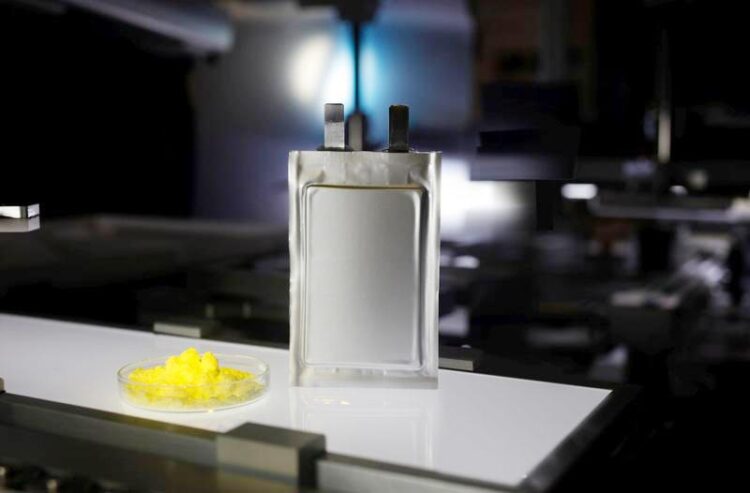Solid-state battery to leap into industrial application

Schwefel mit seiner hohen Speicherkapazität und geringen Materialkosten soll als Kernelement eines vielversprechenden Konzepts für Feststoffbatterien dienen, das die fünf Projektpartner von »SoLiS« in die industrielle Anwendung überführen möchten.
© Fraunhofer IWS Dresden
BMBF project “SoLiS” explores innovative lithium-sulfur battery concepts.
The research project “SoLiS – Development of Lithium-Sulfur Solid State Batteries in Multilayer Pouch Cells”, which started in July 2021, aims to transfer a promising battery concept from basic research into an industrial application. Thanks to high storage capacities and low material costs of sulfur, this cell technology potentially enables the construction of very lightweight and cost-effective batteries. Under the leadership of the Fraunhofer Institute for Material and Beam Technology IWS in Dresden, the German Federal Ministry of Education and Research (BMBF) is funding five partners from science and industry with a total of nearly 1.8 million euro. The research results could, for example, enable applications in electric aviation.
Solid electrolytes are currently the focus of battery research and are considered as a safer alternative to the conventional, highly flammable liquid electrolytes in lithium batteries. In the so-called solid-state battery, these inorganic solids transport lithium ions between the positive and negative electrodes. In combination with new storage materials, they are accordingly the key to safe battery cells with high energy density. After all, liquid electrolytes lead to undesirable side reactions in lithium-sulfur batteries, which have so far resulted in a short cell life. Therefore, the use of solid electrolytes represents a promising solution approach. Current research results are encouraging: the basic feasibility of a Li-S solid-state battery has already been demonstrated on a laboratory scale. However, there is too little data on application-relevant prototype cells, making it impossible to evaluate the technology as of yet.
Aim: Application-oriented proof
The SoLiS project partners consequently pursue the aim of developing battery cells with multiple electrode layers based on Li-S solid-state technology and evaluating them in an application-oriented manner. In addition to the processing and manufacturing methods, they also target the holistic investigation and optimization of the electrodes’ nano- and microstructure. The challenge is to place the storage material sulfur in close contact with electrically conductive carbon and the ion-conducting solid electrolytes. One of the core requirements in the production of the first prototype cells is to manufacture the cell components involved in sufficient quality and quantity. Consequently, the SoLiS project relies on an interdisciplinary team with expertise in the development of innovative materials and processes as well as in electrochemical and structural characterization:
– Fraunhofer IWS takes over the project coordination and contributes know-how on innovative processes for the fabrication of electrodes and prototype cells to the project
– Technische Universität Dresden works on the cathode composite materials and a suitable electrode design
– Scientists at Westfälische Wilhelms-Universität Münster investigate tailor-made solid electrolytes and their transport properties for the new battery type
– Justus Liebig University Gießen contributes its experience and expertise in characterizing interfacial phenomena in solid-state batteries and evaluates possible advantages of additives
– Schunk Kohlenstofftechnik GmbH takes over the production of carbon additives or industrially relevant composite materials
Wissenschaftliche Ansprechpartner:
Dr. rer. nat. Holger Althues
Division Manager Chemical Surface and Battery Technology
Fraunhofer Institute for Material and Beam Technology IWS Dresden
Winterbergstraße 28, DE-01277 Dresden
www.iws.fraunhofer.de
Phone +49 351 83391-3476
holger.althues@iws.fraunhofer.de
Originalpublikation:
https://www.iws.fraunhofer.de/en/newsandmedia/press_releases/2021/press-release_…
Media Contact
All latest news from the category: Power and Electrical Engineering
This topic covers issues related to energy generation, conversion, transportation and consumption and how the industry is addressing the challenge of energy efficiency in general.
innovations-report provides in-depth and informative reports and articles on subjects ranging from wind energy, fuel cell technology, solar energy, geothermal energy, petroleum, gas, nuclear engineering, alternative energy and energy efficiency to fusion, hydrogen and superconductor technologies.
Newest articles

Innovative 3D printed scaffolds offer new hope for bone healing
Researchers at the Institute for Bioengineering of Catalonia have developed novel 3D printed PLA-CaP scaffolds that promote blood vessel formation, ensuring better healing and regeneration of bone tissue. Bone is…

The surprising role of gut infection in Alzheimer’s disease
ASU- and Banner Alzheimer’s Institute-led study implicates link between a common virus and the disease, which travels from the gut to the brain and may be a target for antiviral…

Molecular gardening: New enzymes discovered for protein modification pruning
How deubiquitinases USP53 and USP54 cleave long polyubiquitin chains and how the former is linked to liver disease in children. Deubiquitinases (DUBs) are enzymes used by cells to trim protein…



